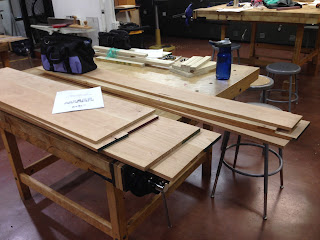Little by little (summer has other obligations) I've been working on Beckvoort's 15 drawer chest. From a construction perspective, it contains a lot of housing dados. I sat down and added them up and came up with a total of 360". That's 30 feet! I like making housing dados by hand with a chisel & mallet and then a router hand plane to get the bottom flat. I am keeping track of the hours so I will have an update when it is done. The dado's are 1/2" wide by 1/4" deep. I say half inch wide but I custom fit the width to the specific piece so it is a tight fit.
One of the side boards developed a bow while cutting the dados. It's most likely due to some stresses in the wood. Wood is organic and it can move. The bow is 5/32" over four feet. I am almost certain I will be able to clamp it out. I am not worried about it. A few years back, I would have been. I guess I've just done enough bigger things at this point and have a feeling what can and can't be tolerated. We shall see on the dry clamping. If it doesn't clamp out, I will deal with it then. All of the layout was done prior to the bow so that is working in my favor.
In Becksvoort's piece (image of final piece from the Becksvoort's Lost Art Press book Shaker Inspiration - well worth purchasing in my opinion), he uses sliding dovetails. I'm guessing since the sliding dovetails are on both sides, it was likely done with a machine router. I don't own one and I haven't yet practiced making sliding dovetails by hand. I didn't want this to be the piece to practice this on. As such, to add some mechanical permeance to the side joinery to the bottom and midway through, I am using a through wedged tenon. I like this joint and have used it on the back of drawers. I don't need to worry about the top as this is dovetailed in and as such is not as reliant on glue. I am sure the glue would be more than adequate. However, I do like to have some joinery that is mechanical in nature so that when the glue fails in 200 years, something else is keeping it together.
Little by little I am getting there. Given the number of pieces to be involved in the glue up of the case, I will likely do it stepwise rather than all at once (too stressful). I've been thinking my way through how to do it best. By best I mean easy. Given I am a hobbyist, speed of glue up isn't important. If it takes me a week (or even two) to get the carcass glued up, it doesn't matter. I'm at least two months out if I had to guess before I will get there. Lots of other things to do other than housing dados before I can glue up the case. I am very much enjoying this build. Wish I could spend a bit more time on it each week but am balancing all the other responsibilities in my life. All good problems.




























